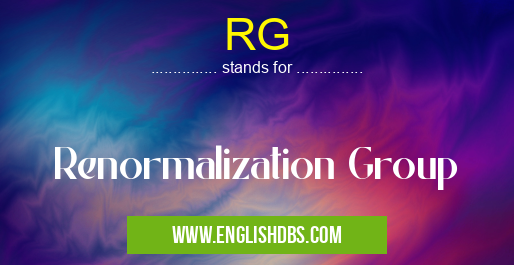What does RG mean in MATHEMATICS
In physics and engineering, the renormalization group (RG) is a collection of ideas involving transformations of theoretical models in order to obtain more accurate results. The basic idea is that an effective description of a physical system can be achieved by changing its scale or resolution; for example, scaling up a microscopic description of an object can give us a more macroscopic view. By transforming the properties of the system, RG allows us to better understand how it behaves under different conditions and can also help us make predictions about its behaviour in the future.

RG meaning in Mathematics in Academic & Science
RG mostly used in an acronym Mathematics in Category Academic & Science that means Renormalization Group
Shorthand: RG,
Full Form: Renormalization Group
For more information of "Renormalization Group", see the section below.
Essential Questions and Answers on Renormalization Group in "SCIENCE»MATH"
What is the Renormalization Group?
The Renormalization Group (RG) is a mathematical tool used to study phase transitions in statistical mechanics and critical phenomena in field theory. It is also used to study how small changes in physical systems can lead to large-scale changes or phase transitions. RG allows researchers to identify which parameters are most relevant and to determine if these universal behaviors are scale-invariant.
How does the Renormalization Group work?
The RG provides a means of understanding how small changes at specific points, often called ‘vertices', can propagate through a system and affect its larger-scale behavior. The method involves studying the effects of small perturbations on an infinite number of points within a graph or network and using that information to build up clear picture of what's happening in between those points. Ultimately, this allows us to gain insight into how interactions at different scales affect the global structure of a system.
What are some applications of the Renormalization Group?
The Renormalization Group can be applied across various disciplines such as physics, chemistry, biology and economics. In terms of physics alone, it has been usefully studied with regards to topics like quantum field theory, many-body systems, critical phenomena and disordered systems. More broadly, its ability to analyze change on increasingly smaller scales has made it increasingly important for research exploring complex systems such as meteorology and climate science.
What is meant by “flow equations†when applied to the Renormalization Group?
Flow equations refer to equations derived from RG calculations that represent how one specific parameter changes as another parameter is varied (i.e., ‘flows'). These equations provide important insights about phase transitions — that is critical points where two distinct phases exist side-by-side — which allow us assess responses in many types of physical systems under extreme conditions.
Is the Renormalization Group theory useful outside physics?
Yes! While originally developed as a tool for physicists working on quantum field theories, it has since been applied elsewhere too including economics, finance and biology in order to understand collective behavior such as market crashes or population dynamics. It helps researchers identify core principles underlying complex networks where different components interact with each other while influencing macroscopic properties over time.
What kind of questions can I answer with the help of RG tools?
With the help of RG tools you can answer questions regarding patterns underlying macroscopic behaviors like population dynamics or market crashes; what causes large scale trends; what behaviours are emergent; how parameters vary on different scales; whether certain behaviours are scale invariant; etc. Ultimately, the goal with RG analysis is gaining insight into underlying causes of complex collective behavior at all levels from microscopic vertices through larger configurations up till big structures.
What do we mean by 'scaling transformations' when discussing RG analysis?
Scaling transformations refer to rescaling techniques used for analyzing large networks/graphs by zooming outwards from any single point or vertex so that details become less visible but patterns become more apparent instead For example such technique could be used when studying flow fields near critical phenomena such as nucleation sites or fluid vortices inside a reactor chamber.
Final Words:
In conclusion, renormalization group provides physicists with powerful tools that allow them to explore strongly interacting systems at various scales and energies. The idea behind RG is to study how physical phenomena are affected by changes in energy or scale; by adjusting these parameters appropriately, investigators can gain deeper understanding into these complex systems, allowing them to solve difficult problems related to condensed matter physics or quantum field theory.
RG also stands for: |
|
| All stands for RG |
